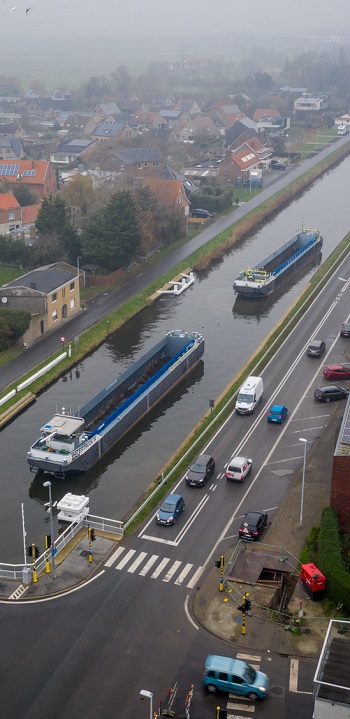Innovations
Watertruck is a new, innovative way of transporting goods that aims to reactivate small inland waterways by introducing a new concept for inland waterway transport.
Innovative concept: the overall objective is to enhance the interconnectivity and interoperability between the TEN-T core network and smaller inland waterways. Watertruck+ is articulated around transport units (barges and push boats) that sail in convoys and can be coupled and decoupled in a fast and flexible way. Loading and unloading are decoupled from the navigation itself, therefore enhancing the service ratio on the smaller waterways.
Innovative design: Watertruck+ provides a universal standard design for various types of small inland barges that can be modified to satisfy the operational requirement of a specific goods flow (cargo flow), propulsion, hatches, lifting (pumping) systems, a small crane, etc. can be added or removed without having a major impact on the overall hull structure. The use of alternative materials (i.e. aluminium, composite) will be examined in order to construct and operate the barges in the most efficient way so that the unit life-cycle costs are limited as much as possible.
Low emissions: Low emissions: the choice of fuel type will be examined, with the aim being to decrease the barges’ noxious emissions. Alternative fuel types such as LNG, CNG, hydrogen, hybrid, will be considered and determined during the project, as well as the propulsion type. CO2 emissions will be reduced by at least 25% and the type of fuel and propulsion system to be used will at least comply with the EURO VI norm of road transport.
Flexibility: Watertruck+ ensures maximum flexibility of operations while maintaining maximum regional coverage by connecting small inland waterways with the TEN-T network.
List of innovations
Logistics Concept: Using push boats and barges is a proven logistics concept.
Innovation: The logistics innovation is the use of self-propelled barges in its concept whereby CEMT I/II inland waterways will be connected to the TEN-T network.
Self-Propelled units: The self-propelled units are an innovation in themself, although they do not exist as of yet in the context of the Watertruck+ concept. They are not described as such in existing standards, rules and regulations.
Cargo: The barges currently sailing these inland waterways are suitable for transportation of different cargoes mainly bulk, containers or a combination. The barges in the Watertruck+ Concept are optimized for different types of cargoes.
Plug-and-Play: The barges have been designed for the higher level specification of being flexible, in contrast to the existing fleet. The application of a modular system in the Watertruck+ barges is innovative. The barges can be plug-and-play converted from non-propelled to self-propelled and vice versa.
- Bowthruster in a dummy box: The bowthruster unit can be easily replaced by a dummy unit.
- Skid: The genset including other necessary equipment is mounted on a skid which allows plug-and-play energy supply.
- The aft thruster channels will be a custom made channel system optimized for manoeuvring and propulsion.
- Wheelhouse: the wheelhouse will be optimized for its plug-and-play function. The wheelhouse has been designed to fulfil an innovative double function, namely being a wheelhouse and hatch-cover in one.
The hull shape: The shape has been optimized and streamlined, for its use as self-propelled barge within the possibilities of the payload requirements, in order to reduce resistance and thus installed power and fuel consumption.
Emission Levels: The barges are prepared for the application of an after treatment installation which makes the barge the first to achieve EUROVI standard emission levels.
Power supply: The use of one genset with after treatment installation ensures that the barges’ emission levels always comply with EUROVI. This also applies during loading and unloading, and in harbor condition if not attached to the shore power system.
38-hour working week: With Watertruck+, skippers can work a 38-hour working week. This makes the job more attractive for younger skippers, since they can thus combine their job with a conventional lifestyle on land. This will make the job more attractive.
